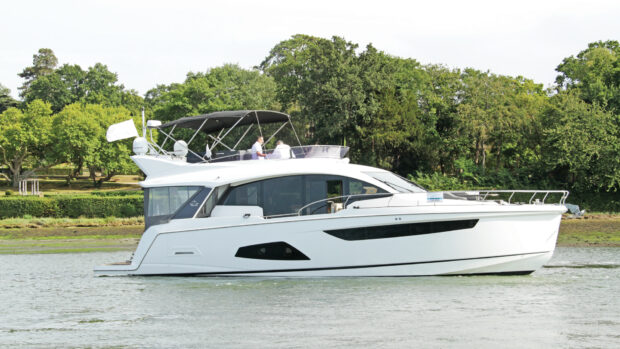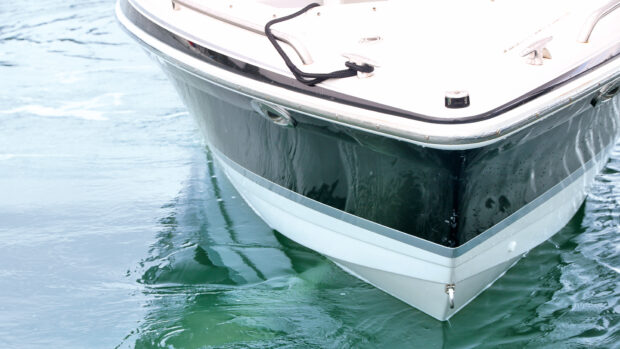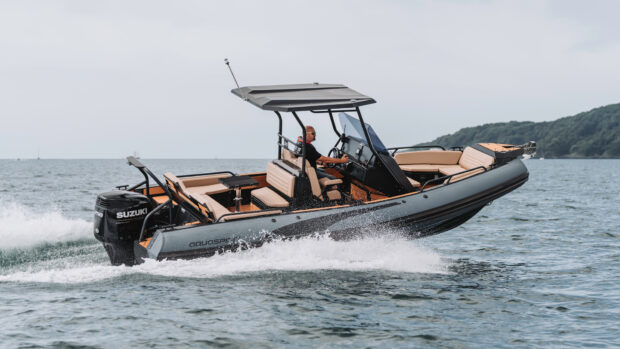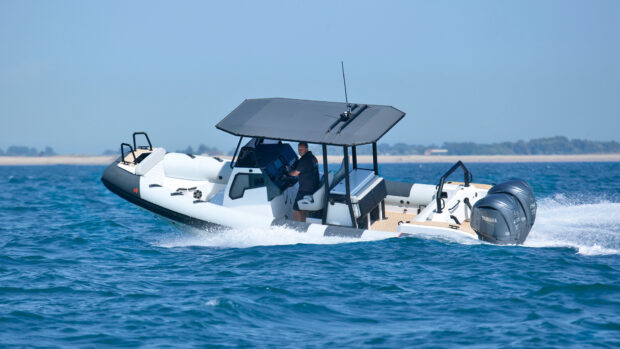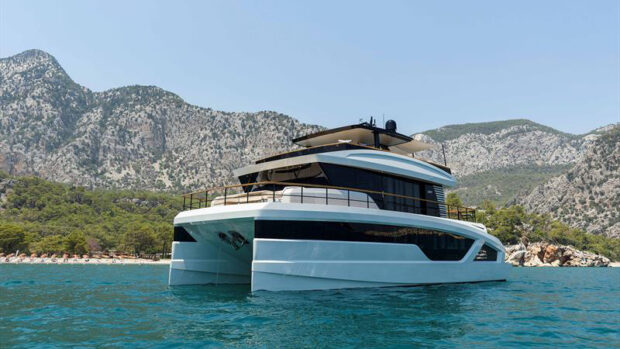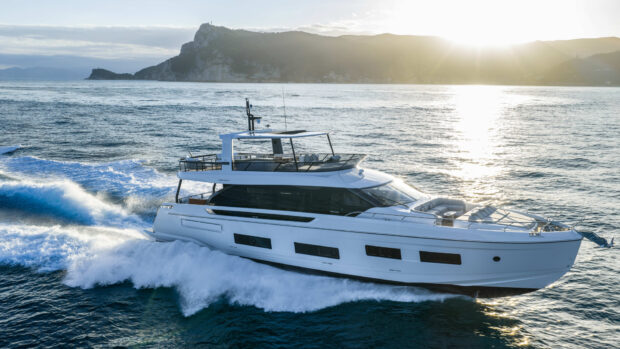Can the sector’s prettiest 80-footer, the Ferretti Infynito 80 live up to its stunning looks? Alex Smith gets onboard to find out
This is a stupendously lovely looking boat – and it becomes all the more so when you view it in its proper context. Consider Princess’s X80 or Sunseeker’s Ocean 156. While they’re both excellent examples of modern crossover yachts, they’re also pretty erudite ambassadors for the fact that making elevation and volume look good is a difficult thing to achieve.
Well, not so here. Other-worldly from the beam, potent from the bow and elegant from the stern, there’s simply no angle without some form of stylistic merit. True, the muscular angles might prove a bit forthright for some but at least what you’re seeing here feels more like a conscious design choice than a side-effect of the vessel’s inherent bulk. But if the dynamic interplay between the tinted windows, fibreglass wedges and cutaway bulwarks is very rewarding, Ferretti’s approach to sheltering the open day spaces also has a big impact.
The full-sized flybridge, for instance, extends way aft above the cockpit seating. It also extends out over the side decks in the style of a trawler yacht before pinching in towards the front end of the pilothouse.
And when it does begin to taper, the superstructure mouldings extend out afresh, covering those side decks and continuing to the bow itself, where a moulded roof structure extends forward from the upper deck, before curving down to integrate with the plumb bow. That creates an entirely covered foredeck lounge with a louvred sunroof so you can enjoy this space both at anchor and underway.

The forward section of the flybridge can be closed off with wraparound glass
It’s neatly rigged to get the best out of that too. There’s a broad chaise-longue-style seat nestling in the V of the forepeak mouldings, plus a forward-facing settee built into the leading edge of the superstructure. There’s also a complex three-part table that goes up and down and forwards and backwards, so you arrange it as a large or small dining station or as one or two low-slung coffee tables.
But what’s really interesting is the way it integrates with the interior space. Lowering the vertical window that separates the internal galley from the external bow delivers magical views (and unrestricted ventilation) for those tasked with cooking. And if you opt for a transverse bar instead of the show boat’s settee, then the guys at the galley get an even better sense of integration with the outdoor guests.
That is of course much handier for self-drive owners than for those who tend to employ crew but it’s a very welcome feature nonetheless, particularly given the size restrictions of the galley itself.
Article continues below…

Pearl 82 review: A boat that succeeds in virtually every regard

Princess X80 review: What we learned from our exclusive sea trial test
Open-air recreation
The rest of the outdoor spaces are equally easy to enjoy. The aft end, for instance, is arranged around a cockpit with an L-shaped bench seat, a compact port unit with sink and icemaker and a starboard ladder to ascend to the flybridge.
It’s relatively pared back but there’s plenty of space for freestanding furniture, as well as for easy dock access, thanks to a pair of side gates. And further aft, via the symmetrical steps on either side of the cockpit, there’s another six-person settee on the swim platform, this time with a relaxed angle of backrest and a lovely view aft.

A large, aft-facing settee is a great way to change the scenery
Step up to the flybridge and you’re greeted with a very similar approach. There’s a huge wraparound sundeck at the aft end that extends well beyond the remit of the hardtop and again, freestanding furniture seems to be the order of the day.
But there are a couple of fixed units too – firstly in the form of a compact starboard cabinet with a worktop and icemaker; and secondly in the form of a port wet bar with grill and sink, plus another fridge and icemaker so you can serve yourself drinks.
The forward end of the flybridge feels more structured. It sits beneath the shelter of a hardtop, which is covered in solar panels so you can run your hotel loads overnight at anchor.
There’s a ten-person starboard dining station under here, plus a pleasantly sculptured settee to port – and it all nestles deep within a framework of bulwarks that rise in tandem with the raked struts for the hardtop to keep everyone in the forward part of the flybridge beautifully sheltered from the elements. But if you want to ramp up that shelter even more, you can also opt for wraparound glass, creating a semi-open or even a fully enclosed forward space.

The huge open-plan saloon is split between dining forward and seating aft
Main deck volume
Back down on the main deck, it’s clear that saloon volume has been a key design priority. It occupies a single-level deck that extends way aft, right out into the cockpit. At its leading edge is a lovely fluted bulkhead, which picks out the light in very pretty fashion. But such is the scale of the saloon that all you get ahead of this point is a set of steps up to the internal helm, a day heads to starboard and that transverse galley that marries up so attractively with the bow.
The saloon, however, is not solely about volume. It’s also about enabling that volume to make itself felt. The bulwark cut-outs, for instance, take the weight out of the profile while improving the views and augmenting the sense of light and space; and the use of freestanding furniture once again achieves the same.

Vertical windows, a single-level deck and peripheral settees maximise the sense of space
In terms of the arrangement, there’s some very slick port cabinetry and a dining table forward, plus some more casual lounge seating aft – but on the test boat, those aft settees cling to the sidelines like nervous children at a school disco.
That leaves a yawning chasm of deck space between the two, so it would be good to see some extra creativity lavished on this part of the boat to better delineate the spaces and perhaps divert your path as you move between them. But of course, as a spacious boat with lots of freestanding furniture from a custom-friendly superyacht builder, adapting the arrangements on the main and upper decks is by no means a tough thing to achieve.
As for the fixed furniture, there are some full-height lockers on either side of the sliding aft doors with breaker panels and dedicated spots for your cutlery, crockery and glasses. And actually, while we’re talking about storage solutions, Ferretti deserves credit for the fact that a great many of the storage spaces on this boat look more like decorative bulkheads than functional cabinets.

The cockpit is all about sheltered deck space and freestanding furniture
But as intimated, when you move forward, it becomes clear that the galley is the zone that takes the most critical hit for the volume in that saloon. There’s space for a hob, an oven, a fridge, a sink, a dishwasher and a small section of worktop.
There’s also a small settee on the starboard side to help make up for the fact that the crew quarters lack any form of socialising space. But even on a 50ft boat, this galley would be a bit average. Yes, it would work fine for a family of four or five but on a platform designed to carry 20 people and to sleep eight guests and three crew, it feels like a slightly lopsided arrangement.

The modern, open-plan bathroom uses glass doors to keep the light flowing
Four-cabin layout
A spiral staircase on the starboard side of the saloon winds its way down, past some neatly concealed washer dryers in the integrated cabinets, to a central corridor. If you head forward from here, you find yourself in the VIP bow cabin – and like the galley, it feels like quite an unusual space.
The forward hull shape on the Infynito 80 is quite acute and the VIP cabin is positioned so far forward and so far down that its footprint is directly impacted by the taper. It also means that the two portlights are too high to admit much light or to enable any views, so if it were down to us, we would head aft and seek out the guest cabins instead.

The forward VIP is the least impressive of the guest cabins
Though it occupies a smaller footprint, the port double has a good size of bed, plus a proper window with natural light and easy sea views. Hanging storage is well taken care of and the ensuite is also very strong, with space for a separate toilet, a sizeable two-person rain shower and another generous window. The starboard twin is equally well appointed, but of course it’s the owner’s cabin that steals the show.
It occupies the full 20ft 10in beam and it also comes with lots of headroom so the proportions really are excellent. And just as in the saloon, the way this cabin is arranged actively accentuates that sense of space. There’s a fore-and aft bed in the centre and a lovely seating area on the starboard side with a dressing table aft and a slim L-shaped settee ahead of that.
The use of high-level storage at the forward end means you can’t actually use this settee in its entirety so getting rid of the raised cabinets would be a useful move. But the mirrored forward bulkhead with concealed TV is a nice touch and the open-plan bathroom on the port side also does a great job of keeping the light flowing.

Like the port double, the starboard twin gets a proper window and plenty of storage
It comes with his-and-hers sinks, as well as aft loo and forward shower compartments, all drenched in light from the big hull window and equipped with glass doors for a very modern feel.
Behind that, the engine bay provides plenty of space for the uprated MAN V12-1400s, as well as for the optional battery bank. But when you head into the crew quarters itself, the space and features are quite basic.
There’s a single cabin to port and a bunk room to starboard with a wet room and heads in the centre and a washer and dryer built into the aft cabinets. But as mentioned, the fact that there’s no space here for a crew seating area puts pressure on the already compact galley to provide one.

While a lot of builders struggle to make volume and elevation attractive, the Infynito 80 is a superb looking boat
Distance and comfort
Perching at the upper helm is an unusual sensation. In spite of the fact that you’re up on the flybridge, a combination of the side mouldings and the screen deflector cocoons you right up to your shoulder. The two vertical MFDs also do their bit to help with wind deflection – and of course, if the weather turns or you’re on a long passage, you also have direct access to the lower helm.
Accessed down a short flight of steps, it provides just a single skipper’s chair so it’s not the most sociable spot in the world but there’s plenty of room for storage along the port side and, thanks to big screens and narrow mullions, you get uncommonly good views above the mouldings for that sheltered bow.

The semi-closed bow with louvred roof provides shelter, as well as view
We have the MAN V12-1400s instead of the V8-1200s on the test boat and, while that adds about a tonne to the weight, this is a 72-tonne boat (light), so the weight penalty makes no great difference. In fact, there’s some pleasing surge to the throttle here and while it might have a voluminous hull, that fine entry gives us a soft and surprisingly dry ride too.
Even when provoked over a little chop in a beam wind, we see no water ingress until the very aft end of those side decks. And, thanks to an 8,000-litre fuel tank and relatively steady fuel consumption figures, range is very solid too.
At 7 knots, we’re seeing just 3 litres per mile for a range in excess of 2,000 miles. Double that speed and 20 litres per mile delivers a 330-mile range. And even at the top end, our range still sits comfortably at around 260 miles.

The bench seat can be replaced with a bar to better integrate with the internal galley
Ferretti Infynito 80 specifications
LOA: 77ft 9in (23.70m)
BEAM: 20ft 10in (6.36m)
DRAFT: 6ft 1in (1.85m)
DISPLACEMENT: 72,000kg (light)
FUEL CAPACITY: 8,000 litres
WATER CAPACITY: 1,200 litres
ENGINES: 2 x MAN V8 1200s / V12 1400s
RCD: A20
PRICE: From €5.95 million ex tax with 1,200hp MAN V8s
BUILDER: www.ferretti-yachts.com
 If you enjoyed this….
If you enjoyed this….
Motor Boat & Yachting is the world’s leading magazine for Motoryacht enthusiasts. Every month we have inspirational adventures and practical features to help you realise your sailing dreams, as well as tests and news of all the latest motorboats.
Plus you’ll get our quarterly Custom Yachting supplement where we share the last on offer in the superyacht world and at the luxury end of the market.
Build your knowledge with a subscription delivered to your door. See our latest offers and save at least 30% off the cover price.
Note: We may earn a commission when you buy through links on our site, at no extra cost to you. This doesn’t affect our editorial independence.
Verdict
The 80ft crossover sector is not without competition. The Princess X80 and Sunseeker Ocean 15) are powerful players – and with its raised pilothouse design and big-volume interiors, the award-winning Pearl 82 is a potential troublemaker for the new Ferretti. But while the crew quarters, galley and VIP cabin fall short of the best in class, the Infynito marries a beautiful aesthetic with a huge flybridge, a voluminous saloon, a fine owner’s cabin and very comfortable passage-making dynamics. It also provides one of the most enjoyable bow arrangements you’re likely to see, so if you’re buying a boat for yourself rather than your crew, there’s a great deal of joy to be had right here.
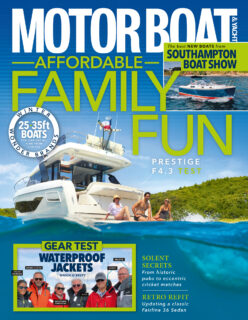



 If you enjoyed this….
If you enjoyed this….